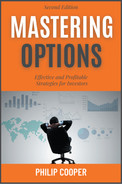Exchange-Traded Options are options traded on a regulated exchange where the terms of every option are standardized by the exchange. The contract is standardized in a way that the underlying asset, quantity, expiration date, and strike price are known to all parties in advance. When options are in the money or at the money, they are characteristically exercised and settled through a clearinghouse.
The characteristics of exchange-traded options are as follows:
• All the option terms are standardized except for the price.
• The exchange will establish the expiration date and expiration prices as well as minimum price quotation unit.
• The exchange will also establish if the option is American or European.
• The exchange will establish contract size and if settlement is in cash or in the underlying security.
• Options are usually traded in lots in which 100 shares of a stock = 1 option.
• Exchange-traded options usually have short-term expirations of 1 to 6 months duration.
• Options can be bought and sold easily and the holder decides whether or not to exercise.
• When options are in the money or at the money, they are typically exercised.
• Most have to deliver the underlying security.
• They are regulated at the federal level in the United States and by the FCA in the UK and Europe.
The underlying assets for exchange-traded options usually are as follows:
• Stocks (stock options) are also known as equity options; these are agreements sold by one party to another. Stock options give the buyer the right, but not the obligation, to buy (call) or sell (put) a stock at an agreed upon price during a certain period of time or on a specific date.
• Commodities (commodity options) are options in which the underlying asset is a commodity such as wheat, gold, oil, and soybeans.
• Bonds (bond options) are option contracts in which the underlying asset is a bond. There is no significant difference between stock and bond options other than the different characteristics between the two assets. Just as with other options, a bond option permits investors to hedge the risk of their bond portfolios or gamble on the direction of bond prices with limited risk profile. A buyer of a bond call option is expecting a decline in interest rates and an increase in bond prices. The buyer of a put bond option is expecting an increase in interest rates and a decrease in bond prices.
• Stock Market Indexes (index options) are call or put options on a financial index, such as the Nasdaq, S and P 500, or FTSE100. Investors trading index options are essentially predicting the overall movement of the stock market as represented by the basket of stocks in the index.
• Options on futures are options on a futures contract where the option holder has the right but not the obligation, to buy or sell a specific futures contract at a specific price on or before a certain expiration date. These grant the right to enter into a futures contract at a fixed price.
• Forex (currency options) is a contract that gives the holder the right, but not the obligation, to buy (call) or sell (put) currency at a specified price during a specified period of time. Investors generally use these types of option to hedge against their foreign currency risk by purchasing a currency option put or call.
